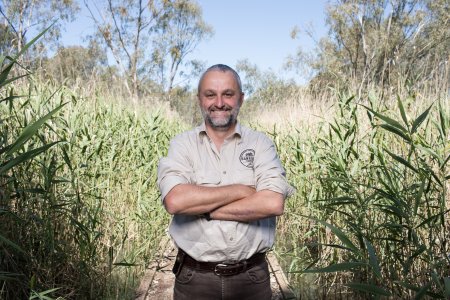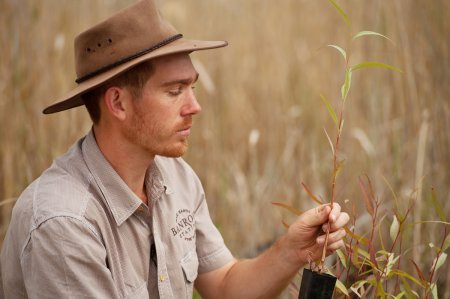Banrock Station: how a Ramsar wetland owned by a private agribusiness in South Australia became a cultural and educational hub

Banrock Station in South Australia has been owned since 1993 by one of the major wine-producing businesses in the world: Accolade Wines (formerly Hardys Wines). In 2000, the Banrock Station Wine and Wetland Centre opened to the public for the enjoyment of wines and al-fresco dining on local produce and native foods while overlooking the river floodplain. The Centre is also the starting point of an 8 km self-guided network of walking trails with boardwalks and bird hides, that leads visitors to the heart of the wetland. In 2002 the site was declared as one of Australia’s Ramsar Sites.
In parallel with the development of a vineyard, the company initiated the restoration of more than 1,500 ha of wetlands and adjoining woodlands. In 1993, sheep and cattle were removed and restoration of wetlands and woodlands began. Banrock Station was the first site in South Australia to implement an active management of its wetlands through the re-establishment of a more natural hydrological regime, with a succession of wet and dry phases. In 2007, with the support from the State Government, Banrock Station was able to relocate the vineyard irrigation pumps from the main lagoon to the river. Banrock Station then became able to re-create a complete dry phase in late summer and autumn, and to replicate a more natural hydrological regime consisting of winter/spring floods and summer/autumn drying. Thanks to these measures, the wetland has now been returned to a healthily functioning ecosystem. Introduced European carp have been removed and soil structure improved, while native fauna and flora have returned. Reintroducing the dry phase in the seasonal cycle also saves precious water, with about 1.15 gigalitres of river water being saved from evaporation over two years.
Over 310 flora and 250 fauna species have so far been recorded on the site, some of which are of national conservation importance. At the time of writing, Banrock Station has become the number one bird hotspot in South Australia, and the 35th in Australia as a whole. Banrock Station was selected in 2013 as a site for the reintroduction of the Spiny Daisy (Acanthocladium dockeri), a nationally threatened species, thought to be extinct since 1910.

Indigenous Australians consider land and water to be intimately intertwined; therefore the whole ecosystem has social and cultural value to the Indigenous Peoples of the region. Banrock Station Ramsar Wetland Complex contains significant artefacts that suggest that the site was used and occupied by Indigenous Peoples, and valued for a range of natural resource uses and strategies (e.g. camp-sites, hearth/fire places, middens, lithic artefacts and scar trees). There is strong belief that Banrock Station was important for trade and access by Aboriginal groups to the Murray River, as the site was near to a ration station in the 1880s, and lies probably on the former boundary of two Aboriginal groups (Erawirum and Nawait). The site is therefore recognised for its cultural significance to Indigenous Australians.
In more recent times, each year, official representatives of the South Australian and inter-state police forces meet by a memorial on Banrock Station for National Police Remembrance Day, in memory of police officers killed in the line of duty. Just three kilometres from the memorial the first casualties of the South Australian Police were recorded on 7th May 1847, when two policemen drowned while trying to cross the river on a canoe.
Banrock Station has become a popular tourism and education destination, welcoming on average 60,000 visitors per year. Through a network of relationships with the state education institutions, Banrock Station has engaged children in habitat restoration and wetland monitoring and awareness programmes since the 1990s. The site hosts on average two school/university visits per month. The interest in Banrock Station for environmental education has gone beyond state and even national borders: since 2005, international volunteers through the International Student Volunteers (ISV) programme have planted thousands of trees, tracked feral animals, installed nest boxes for birds and bats, completed construction projects, undertaken fencing, ecological monitoring and control of weed infestations throughout the property.

Dr. Christophe Tourenq, Conservation and Wetland Manager
Christophe has over 20 years’ experience in research and nature conservation spanning the Mediterranean, Middle East and Far East, and has a wide and extensive knowledge of nature conservation in wetlands and desert habitats including Ramsar Sites. After completing a PhD on waterbirds and ricefields in the Camargue, Southern France, in 2000, he moved to the United Arab Emirates, where he worked for 10 years, firts for a local governmental environment agency and then for an international NGO on species and habitat conservation. Christophe moved to Australia in December 2011, and through his interest in water resources, he joined Banrock Station to manage one of Australia’s 65 wetlands of international importance under the Ramsar Convention.

Tim Field, Ranger Ecologist
Tim grew up in the South East suburbs of Melbourne, where he studied Natural Resource Management. Since 2004, Tim has worked on various conservation and land restoration projects along the Murray River and also in fox control, wildlife monitoring, threatened species management and floral surveys in Far East Gippsland. After volunteering on the Australian Antarctic Division base to research and monitor Fur Seal populations, he was welcomed to Banrock Station to work on enhancing the diversity of the area through developing a restoration and revegetation programme, as well as looking at new ways of working towards an integrated animal pest management programme on the property.